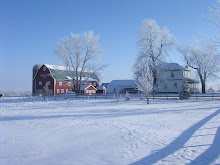Arriving at West Highland Dairy to make cheese was a monumental day for me. I was a long way from the computer monitors and keyboards, chips and programs that had dominated most of my life up until now. This was something totally different. I had done quite a lot of research about cheese making prior to making this trek. I visited cheese plants in Wisconsin to witness the process, read a pile of books and had even watched movies, DVDs and TV shows about it. But when I got there I was amazed at how small and neat an operation can actually be. A place for everything and everything in its place. No giant "swimming pool size" vats. No shouting, loud music or the crashing of stainless steel shovels and rakes and other implements of destruction. No pumps screeching, milk and whey flying or clattering air compressors competing with the hiss of steam .
It was calm, the windows were open and a light breeze blew through off of the loch creating a kind of meditative atmosphere. It was the Zen of cheese making and you could sense a feeling of tranquility and calm in the air. Kathy and David make cheese to fill the orders that they received from their clients on their Internet site and maintain a small retail shop on one end of the creamery. Many cheeses, yogurt and ice cream were always on offer to locals and tourists that would stop by all day long.
There were three of us in my class. The other two were women from England that lived on farms and were considering setting up their own cheese making operations to increase the income on milk that they produced on the farm. Calling it a class might make it sound far more formal then it was as we would be making cheese along with Kathy who was also making cheese for the business. Since she has been professionally teaching cheese making at universities for many years in England and is often a guest instructor at several farmstead cheesemaking organizations from New York, Connecticut and Massachusetts it was very well organized without the structure competing with the enjoyment. You came to realize that cheesemaking is defined by very scientific rules such as the "schedule of acidification" measured by calculating the titratable acidity of the whey that we constantly checked. And yet you didn't want to lose the artistic side of the process, the "feel" of the cheese or the "smell" or "look" that you can only learn through experience with the guidance of an actual practicing cheesemaker that is pointing the way. We each had our choice of what we wanted to make as our main project and we got to help with yogurt and crowdie which is a local soft cheese. I decided to try Double Gloucester as I would want to make a variety of hard pressed English type cheeses in our creamery should I decide to continue this project.
Now to make some cheese.
Subscribe to:
Post Comments (Atom)

No comments:
Post a Comment